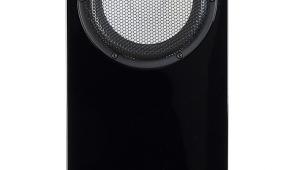Falcon Acoustics Reference GC6500R Loudspeaker

 Two-dimensional wonder-material, Graphene, is making its way into driver cones, including Falcon's flagship
Two-dimensional wonder-material, Graphene, is making its way into driver cones, including Falcon's flagship
Oxfordshire-based Falcon Acoustics is perhaps best-known for two aspects of its business: first, it's a major supplier of drive units, both its own designs and those of partner companies; and second, it's the manufacturer of its own version of the classic LS3/5a speaker design [HFN Jan '19]. The Falcon Acoustics Classic 15ohm LS3/5a is fully BBC-licensed, hand-assembled in Oxford and 'the only LS3/5a in production that faithfully replicates the original BBC design published in Oct 1976'.
That's hardly surprising, given that the speaker uses the company's T27 tweeter and B110 bass unit, both designed by Falcon founder Malcolm Jones, who was responsible for the original KEF T27 and B110 drivers when he was with that company. But the LS3/5a isn't the only string to Falcon's bow, for at the other end of the spectrum sits the 1.2m-tall, 70kg-apiece Reference GC6500R floorstanding speaker, available in a range of high-gloss colours or deep real wood veneers, and selling for a fiver short of £20,000 per pair.
Luted Objects
Big and bold-looking, though hardly the most humungous speakers to pass through these doors in recent times, the GC6500R exudes a air of luxury thanks to those veneers, a smoked glass top panel and Alcantara (high quality synthetic suede) on the front baffle. The purposeful solidity and sheer heft of the cabinets is made all the more elegant by their lute-like shaping while the substantial cast alloy outriggers are fitted with some seriously heavy-duty spikes for rock-solid stability.

The enclosures themselves are made in Italy, the source of some of the best furniture-grade cabinets in the business, and are built from 25mm-thick laminated MDF with an extra 9mm of internal damping, over which those exotic – but not too frivolous – finishes are laid. The front baffle is even thicker, at 38mm, and is profiled for minimal diffraction (for which that microfibre suede covering also helps) with chamfered cut-outs for the drive units to optimise dispersion.
Glam Metal
The 18mm rear panel is reinforced with a custom metal tooling that also provides heatsinking for the attached crossover and a location for the single set of custom-made nickel-plated terminals. All the metalwork found here is machined from top-quality MIC6 cast aluminium plate by what the company describes as 'F1 ultra-precision engineers'.
So there's clearly a lot going on in this speaker, and that's before we even get to the drive units, the most striking feature of which is the use of ultra-strong, ultra-light Graphene in the mid/bass drivers. The twin 18cm bass drivers are described as 'Sonaweave Graphene Enhanced Nano-Platelet Composite Cone' woofers, the Graphene 'coating' allowing them to be made 60% lighter and thinner than conventional cones, yet with superior rigidity and damping. They're reflex-loaded using a hidden, downward-venting port working into the space created by the plinth-and-spike assembly.
Above the bass units sits the 5cm dome midrange driver, mounted in a hypocycloid (think Spirograph-drawn circles within circles) wave guide designed after extensive computer modelling. This mid unit was seen in the R.A.M Studio 30 floorstander [HFN Apr '19], modified here to lower distortion and yield a smoother sound. The ribbon tweeter has also been 'tweaked', all in the quest for a smooth response. The faceplate apparently plays a major part in this while the heavyweight crossover PCB uses gold-plated copper tracks, close tolerance air core inductors and polypropylene capacitors.

















































